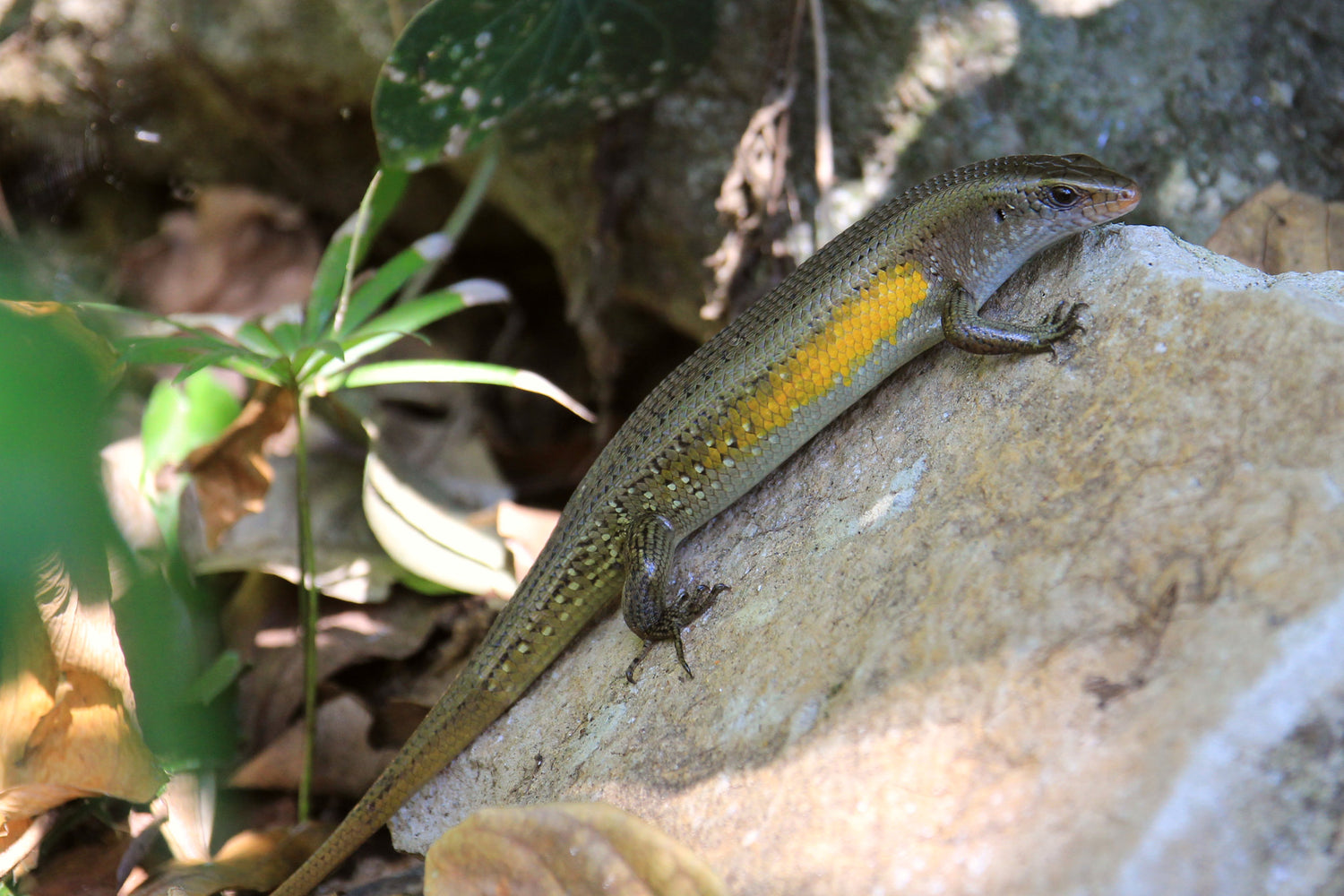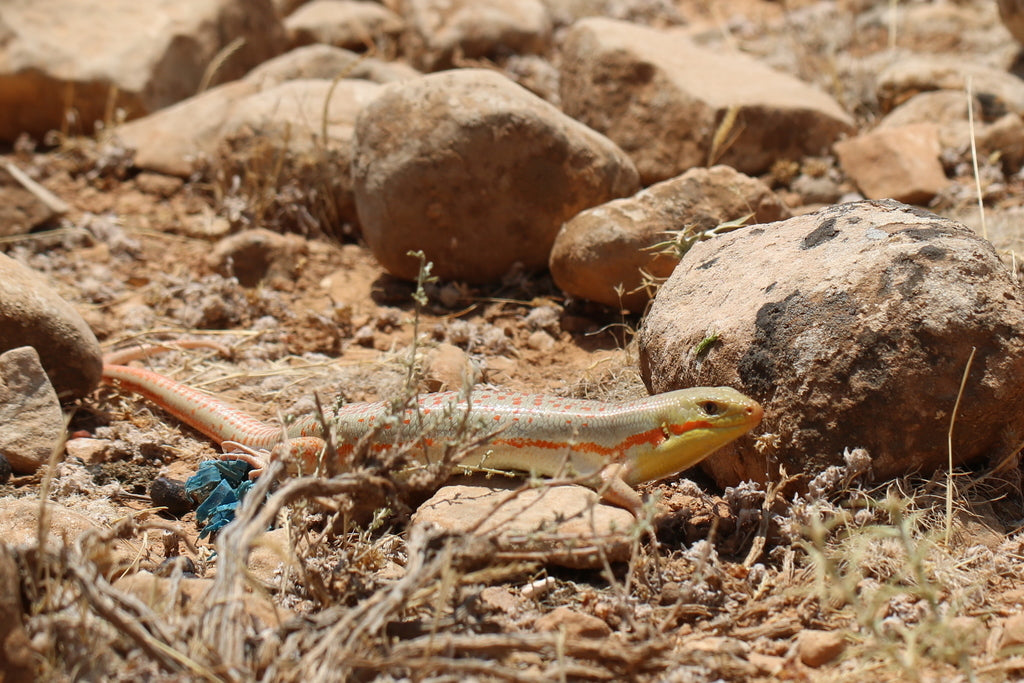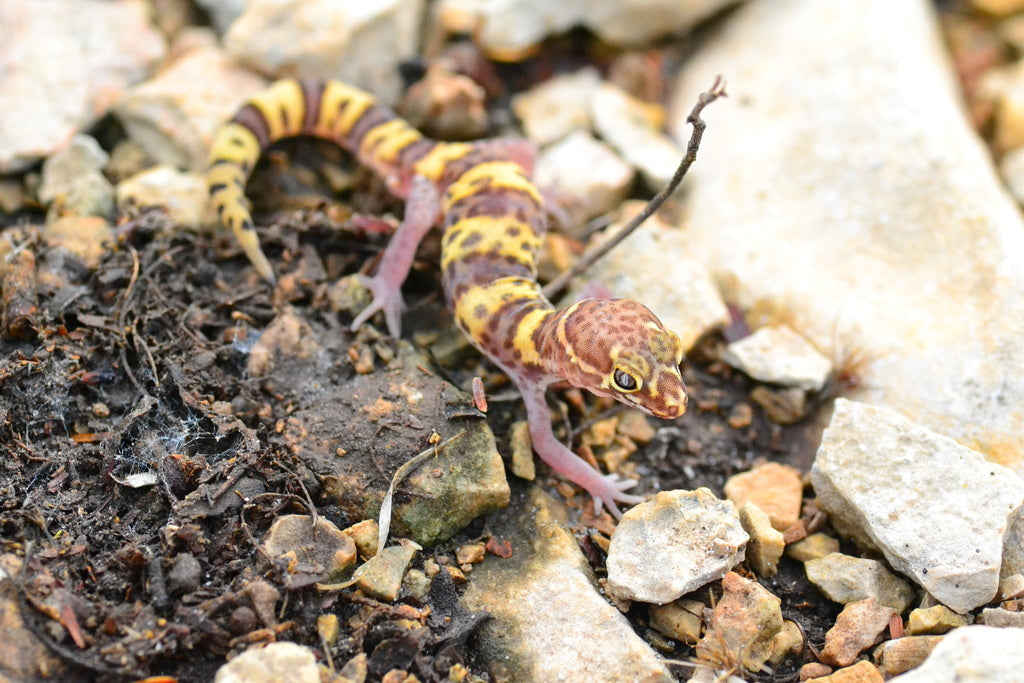Sun skinks (Eutropis multifasciata) are small, diurnal, terrestrial lizards primarily found in southeast Asia, although there is an invasive population in Florida, USA. This species is widely distributed, found mostly in primary and secondary forest habitats.
Sun skinks grow up to 13” long, with a small head, pointed snout, robust body, triple-keeled scales along the back, and a long, slender tail. Coloring and pattern vary slightly by locality, but they typically have a bronze-ish base color, and the sides may be dark, yellow, or red-orange. The throat may be white or yellow.
Sun skinks are considered to be fairly hardy in captivity, and can become relatively tame when captive-bred. With good care, they can live for at least 8 years.
How much space do sun skinks need?
A single sun skink should be housed in no smaller than a 36”L x 18”W x 18”H enclosure. This species is very active and quick, so even more space is likely to be used regularly if provided!
Cohabitation (keeping multiple sun skinks in the same terrarium) is not required for this species’ wellbeing, but it can work for groups of females or a breeding group of one male and multiple females. Up to three skinks can be housed in a 48” x 24” x 24” enclosure. Males should never be housed together due to the risk of violent conflict.
Do sun skinks need UVB?
Yes!
Sun skinks require UVB lighting to stay healthy in captivity. They are a diurnal species often observed basking in the morning. The best UVB bulbs for a sun skink housed in a 18” tall enclosure are:
- Arcadia T5 HO Forest 6%, 22”
- Zoo Med T5 HO Reptisun 5.0, 22”
When the UVB is mounted over mesh, the basking area should be placed 7-9” below the lamp. The basking area should be the closest surface to the UVB bulb. The UVB bulb should be housed in a reflective T5 HO fixture like the Arcadia ProT5 or Vivarium Electronics, and placed on the basking side along with the heat lamp.
Note that UVB is blocked by glass and plastic, so you can’t give your lizard UVB by placing its terrarium in front of an open window. Also make sure that the fixture your UVB bulb is in does not have a clear plastic bulb cover. UVB bulbs must be replaced every 12 months to remain effective.
In addition to UVB, since sun skinks are day-active, it’s beneficial to provide an additional daylight-spectrum lamp to make sure the enclosure is brightly illuminated. Use a strong 6500K LED or T5 HO fluorescent plant grow light across the majority of the enclosure for best results.
Lights should be on for 13 hours/day during summer and 11 hours/day during winter, or synced with your local sunrise and sunset times.
What basking temperatures do sun skinks need?
Sun skinks like the heat! They should have a basking temperature between 95-105°F, with a cool side temperature of 80-90°F. Turning off the lamps at night to allow nighttime temps to drop as low as 70°F. Measure your temperatures with two digital probe thermometers with each probe placed on the desired surface.
Provide heat for your sun skink by imitating the sun with two 50w halogen flood heat lamps clustered on one side of the enclosure. Do not use ceramic heat emitters (CHEs), heat mats, red bulbs, or blue bulbs, as these are not as effective. For best results, the basking surface itself should be a flat stone.
What humidity levels do sun skinks need?
Sun skinks prefer a humid habitat with an average humidity between 70-80%. To achieve the needed humidity levels, mist the enclosure 2x/day with a pressure sprayer. It can also help to mix water into the substrate. Humidity levels should naturally fluctuate lower during the day and higher at night.
Monitor humidity levels with a digital probe hygrometer with the probe placed in the middle of the enclosure.
What substrate is good for sun skinks?
Substrate helps maintain healthy humidity levels and contributes to the enclosure’s overall attractiveness, and also provides a burrowing medium. We recommend the following substrates for sun skinks:
- Zoo Med ReptiSoil
- Zoo Med Eco Earth
- Exo Terra Plantation Soil
Alternatively, you can mix your own substrate with 60% topsoil and 40% coconut fiber, measured by volume.
Substrate should be at least 3” deep and completely replaced every 3-4 months. Remove poop and urates daily, along with contaminated substrate.
What décor can you use in a sun skink terrarium?
It’s terribly boring for a sun skink to be stuck in an enclosure with nothing in it except substrate and food/water bowls. It doesn’t matter how big the enclosure is if you don’t put things in it for your pet to use and interact with!
Sun skinks will appreciate a fairly cluttered enclosure that gives them plenty of things to hide in and climb around on. Here are some ideas for ways to create the perfect setup for your pet:
- cork tubes
- cork flats
- branches
- ledges
- live or artificial plants
- additional hides
- rock stacks
- textured background
What do sun skinks eat?
Sun skinks are primarily insectivorous, which means that they need to eat insects (preferably live) in order to get the nutrition that their bodies need. Offer as many insects as your skink is willing to eat in a day. If your pet is starting to look fat, reduce feedings to every other day.
Feeder insects for sun skinks: dubias, discoids, red runner roaches, red head roaches, crickets, black soldier fly larvae, small hornworms, silkworms, mealworms, mealworm beetles
Fruits such as banana, papaya, and berries can be offered as occasional treats.
Supplements
You will need calcium and vitamin supplements to help prevent your lizard from developing a deficiency. We recommend Repashy Calcium Plus LoD, lightly dusted on all of your lizard’s feeder insects. It’s okay to skip a dusting every once in a while.
Water
Provide a medium water bowl where your lizard can always get a drink when needed and soak its body as desired. Change the water daily and scrub the bowl with a reptile-safe disinfectant weekly, or whenever it becomes soiled.
Do sun skinks like to be handled?
Few reptiles actually “like” to be held, so don’t be alarmed if your sun skink seems skittish and runs away as soon as you open the enclosure door. However, they can be tamed with patience, particularly if captive-bred and started young. Start teaching it to trust you by hand-feeding it with a pair of feeding tweezers.
*This care sheet contains only very basic information. Although it’s a good introduction, please do further research with high-quality sources to obtain additional information on caring for this species.
"Eutropis multifasciata" by DavideGorla is licensed under CC BY 2.0.




Leave a comment
This site is protected by hCaptcha and the hCaptcha Privacy Policy and Terms of Service apply.